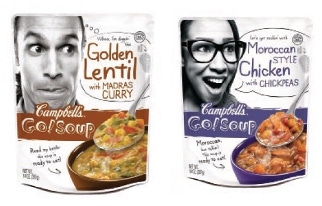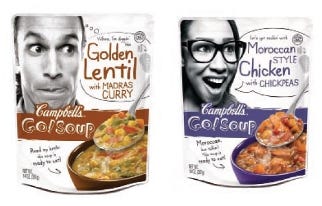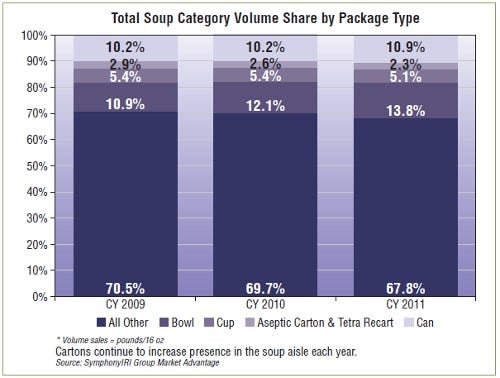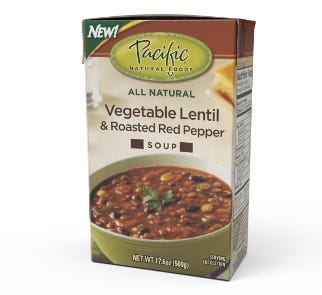Millennials judge food by its cover
March 11, 2015


Campbell
Notorious for being marketing savvy, environmentally conscious and socially empowered consumers, Millennials are shaking up a range of industries—from fashion to entertainment to automobiles to insurance. Now, food manufacturers and retailers are offering new products to capitalize on the opportunity with young adult shoppers.
Food companies are realizing that time-tested package designs like cans, jars and bottles in many ways do not jive with the Millennial lifestyle and this generation's unique attitudes towards food, health and the environment. These insights are spurring innovations throughout the supermarket-but particularly in the center of the store, where shelf-stable cartons and pouches are beginning to displace traditional canned goods.
Early adopters are already reaping the benefits of these new packages, which boast features that appeal equally to Millennial consumers and food producers' bottom lines. And while cans aren't likely to disappear anytime soon, it is clear change is afoot.
As Millennials edge closer to maximizing their spending power and household sizes, major food producers are likely to embrace these new "Millennial-friendly" packages on a much wider scale.
Meet the Millennials
Millennials are generally defined as the group of young adults age 16 to 34 in 2012. They now number 79 million, making them a larger demographic group than Baby Boomers (at 76 million) for the first time. One-fourth of Millennials now have children, and this number is steadily growing.
Although Millennials have been among the hardest hit by the Great Recession, a recent study by youth trend agency Y-Pulse points to a brighter future ahead. From 2009 to 2011, total spending by Millennials grew 13 percent, to total $306 billion annually. Discretionary spending grew nearly 10 percent during this same period, to $69 billion from just under $63 billion.
All of this makes Millennials an attractive target for food marketers. New products and package types will help attract and retain this generation, which has notably different attitudes towards food, health and the environment.

Soup Volume by Package Type chart
Convenience, affordability are key
According to The NPD Group, which has tracked eating trends in the U.S. for 30 years, Millennials are much more likely than earlier generations to use convenience foods, including frozen entrees and other foods requiring minimal preparation. Prepared fruits and vegetables have experienced an uptick in sales as well, increasing nearly 20 percent between 2006 and 2010.
Often on the go, Millennials are also significantly more likely than other age groups to purchase foods from convenience stores and one-stop-shop mass merchandisers. One-third of Millennials use mass merchandisers such as Target as their primary store, compared to just 23 percent for all adults.
For Millennials, convenience foods are more than just microwaveable; it's no longer simply about feeding oneself fast, but feeding oneself well and efficiently. Millennials want meals they can prepare and eat quickly, with little or no cleanup—and minimal leftovers. The average Millennial eats nearly one-third fewer meals per year involving leftovers than adults in their late 30s and 40s.
Millennials want healthy food
Millennials also pay close attention to what is in their food, and are especially interested in organic foods. Thirty percent of Millennials say they "regularly" eat foods that are certified organic. This compares to just 15 percent for Boomers. Millennials express skepticism about chemicals, preservatives and excess calories. They are unwilling to sacrifice health or quality for the sake of convenience. This mindset underlies numerous changes by food manufacturers. Nestlé increased the "nutritional density" of its foods by featuring more fruits, vegetables and whole grains. Convenience stores like Kwik Trip and others now offer bananas and other fresh fruit for Millennials on-the-go.
Cartons, pouches offer special appeal
To capture the new mindset of Millennials, food producers are introducing new products in innovative packages. One of the most notable packaging advances is shelf-stable cartons that can now accommodate a greater range of foods. Traditional shelf-stable cartons work great for liquids that are all of the same consistency. The new "retortable" cartons can accommodate chopped or diced fruits and vegetables, as well as chunky soups.
According to SymphonyIRI Group Market Advantage, soups packaged in cartons like Pacific Foods soups, are helping reverse a marked 10-year decline in soup purchases by consumers age 25 and under.
In the last year, carton use in prepared foods grew 11 percent. This increase is in large part driven by growth in soup and broth packaged in cartons, at the expense of cans. Volume sales for soups in cartons are up 22 percent since 2009, with dollar sales up 14 percent. SymphonyIRI found that "consumers perceive products in cartons to be fresher, more natural and better tasting." Cartons have significant advantages over cans, including engaging graphics, light weight, recloseability, easy storability and the elusive "cool factor."
Campbell's Soup has taken notice of Millennials' interest in new packaging and flavors, and is developing a new concept called "GoSoup," a line of pouch-packaged soups. Campbell's is designing the line with Millennials in mind, as the pouches offer their own advantages over cans, including high-quality graphics, microwaveability and portability.
Why cartons are winning with Millennials
Earlier this year, Brand Amplitude conducted research on packaging preferences as part of its on-going exploration of Millennial attitudes and behavior. The proprietary research among male and female grocery purchasers was conducted April 2012 in collaboration with a food packaging company to explore Millennial preferences among alternative package types and reasons for preference.
The research shows Millennials in this survey (age 24-35) perceive the most important benefits of carton packaging to be that it is healthier, keeps food tasting fresher and is easy to recycle. Nearly three-fourths of Millennials say they would choose a leading brand of soup packaged in a carton over the identical soup product in a can in a theoretical head-to-head comparison. Ease of storing the unused portion (49 percent) and eco-friendliness (46 percent) are the top two reasons given for their choice. Forty-three percent said that taste (less likely to have a tinny or processed taste) motivated their preference.
In the same study, in a theoretical head-to-head comparison with a pouch concept, more Millennials chose the soup in a carton. The top two reasons for their preference were "easier to store" (52 percent) and "easier to pour" (42 percent). The square shape of retortable cartons may ultimately give cartons the edge over pouches in capturing Millennial shoppers, as they are easier to store in small pantries or kitchens. In addition to easy storage, cartons are lightweight, compact and made mainly from paper, a renewable resource.

Pacific soup carton
A winning combinationPackaging is not all that is new. Companies like Pacific Foods and Soupman feature more exotic, Millennial-friendly flavors in their carton-packaged soup and vegetable offerings. Flavor options include Cashew Carrot Ginger, Seafood Bisque and Roasted Red Pepper and Tomato.
The combination of interesting products plus interesting packaging may prove to be the ticket to revitalizing "center of the store," shelf-stable product categories. By offering more convenient packages with new flavors and a perceived fresher taste, cartons in particular appear to offer manufacturers a winning approach to attracting the elusive and demanding Millennial consumer.
Martin Predd is research director at Brand Amplitude, a customer insights and brand strategy consulting firm known for its Millennial marketing expertise. He can be reached by emailing [email protected].
Brand Amplitude, 269-429-6526. www.brandamplitude.com
The NPD Group Inc., 516-625-0700. www.npd.com
SymphonyIRI Group Market Advantage, 312-726-1221. www.symphonyiri.com
Y-Pulse, 888-292-8855. www.ypulse.com
.
About the Author(s)
You May Also Like


